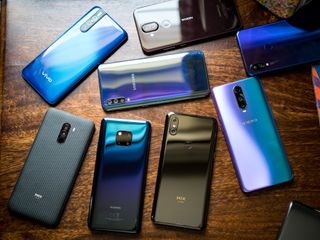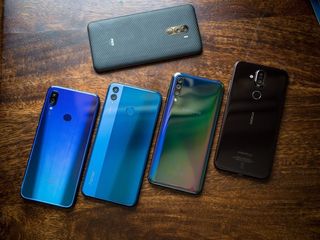U.S. customers are missing out on the latest phone innovations

The U.S. is the world's largest smartphone market, but lately, it has been missing out on new innovations in phone design. Over the last 12 months, we've seen a sea of change in smartphone design. Manufacturers adopted new and innovative ways to reduce bezels, with cutouts being the default option.
We've also seen a few companies like Vivo and OPPO introduce pop-up mechanized sliders that do a better job hiding the front (and even the rear) cameras. The latest designs coming out of China are some of the most interesting we've seen in the smartphone segment, but they're not coming to U.S. shelves anytime soon.
The latest phone designs aren't coming to the U.S.

The Vivo NEX was the first to feature an all-screen front. and barring a few inconsistencies with the software, it was an exquisite phone for its $650 sticker price. In fact, it still continues to be one of the best phones to play intensive titles like PUBG.
Chinese companies are pushing the boundaries for design — and U.S. customers are missing out.
OPPO shortly followed up with its own take on sliders, the Find X. The Find X was even more radical in that the slider contained both the front and rear cameras, and the phone had facial unlock as the primary means of authentication. The more mainstream R17 Pro doesn't have a sliding camera, but it comes with 50W fast charging and one of the best gradient patterns I've seen so far.
Vivo is now going all-in on retractable cameras, bringing the tech down to the $300 segment with the V11 Pro. The company is also working on an insane design that has no buttons or ports. The NEX was born out of a similar idea last year, so it's exciting to see what comes out of Vivo in 2019.

Then there's the Mi Mix 3, a phone where the entire screen slides down to reveal the front cameras. The Mi Mix 3 is an engineering tour de force with a ceramic chassis, sliding screen, razor-thin bezels, and powerful hardware. It's on sale in a few Western markets — notably the UK — where it's available for just £499 ($660), but the phone won't be hitting U.S. shelves. Xiaomi's latest flagship won't be making its way to the U.S. either. The Mi 9 is the first phone from the brand to feature three cameras at the back, and it also comes with a 20W wireless charger.
Huawei made some of the best phones last year, but with its products banned in the U.S., customers are missing out on the fantastic camera on offer with the Mate 20 Pro, or its upcoming foldable phone, the Mate X.
Be an expert in 5 minutes
Get the latest news from Android Central, your trusted companion in the world of Android
Chinese manufacturers have pushed the boundaries of design over the last 12 months, and customers in the world's largest smartphone market haven't had access to any of these phones. The U.S. market is firmly revolving around Apple and Samsung, which cumulatively accounted for 69% of smartphone shipments in Q4 2018.
The budget category is even more woeful

As limiting as the options are when it comes to the flagship space, the situation is even more dire in the budget segment. The Moto G7 is one of the best budget phones you can buy in the U.S., and it's running a Snapdragon 632 chipset. The most powerful of the sub-$400 phones in the U.S. — the Nokia 7.1 — is powered by the Snapdragon 636 platform.
For that same amount, you can get your hands on the POCO F1 in the UK, which has a Snapdragon 845 with liquid cooling and a 4000mAh battery. Then there's the fact that there are no devices powered by the Snapdragon 660, 670, or the 675 platforms in the U.S.
Qualcomm's latest mid-range chipsets are fantastic, but they're not on sale in the U.S.
Qualcomm has made considerable improvements to its mid-tier chipsets over the last 18 months, and there just aren't devices that leverage those improvements in the U.S. Contrast that to the dizzying array of options that are available in India, and you'll begin to see the disparity.
The Moto G6 Plus was effectively dead on arrival in India last year as there were at least five phones that offered better hardware at a lower cost.
Xiaomi released the Redmi Note 7 Pro earlier this year in India, offering a Snapdragon 675, 48MP camera, and 4000mAh battery with Quick Charge 4. There's the ASUS ZenFone Max Pro M2, which has a Snapdragon 660 for under $200, the Kirin 710-touting Honor 10 Lite, the $390 Nokia 8.1 with Snapdragon 710, and the list goes on and on. Even Samsung is getting in on the action with the Galaxy A50.
The sheer competitiveness of the Indian market has driven prices down over the last two years, with $150 phones now offering stellar hardware. That said, it's not easy for Chinese manufacturers to break into the U.S. — as we've seen with LeEco — as it requires a sizable investment and carrier deals.
One of the key announcements out of OnePlus' 6T launch was that the company was partnering with T-Mobile to sell its phone at retail stores across the country. It was a major win for OnePlus, but the company doesn't sell anywhere close to the same number of devices as Xiaomi, OPPO, or Vivo.
Sure, the U.S. market requires more overhead as manufacturers need to partner with carriers for distribution, so it's unreasonable to assume that Chinese brands would be able to sell their devices at such low prices even if they introduced them Stateside. But the fact that no one is even trying tells volumes about the state of the U.S. market.

Harish Jonnalagadda is a Senior Editor overseeing Asia at Android Central. He leads the site's coverage of Chinese phone brands, contributing to reviews, features, and buying guides. He also writes about storage servers, audio products, and the semiconductor industry. Contact him on Twitter at @chunkynerd.
